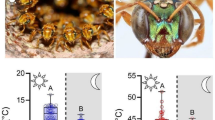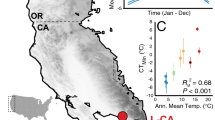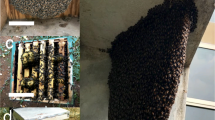Abstract
Seasonal variation in metabolic rate and evaporative water loss as a function of ambient temperature were compared in two species of bees. The endemic blue-banded bee, Amegilla chlorocyanea, is a solitary species that is an important pollinator in the south-west Australian biodiversity hotspot. Responses were compared with the European honeybee, Apis mellifera, naturalised in Western Australia almost 200 years ago. Metabolic rate increased exponentially with temperature to a peak in both species, and then declined rapidly, with unique scaling exponents and peaks for all species-by-season comparisons. Early in the austral summer, Apis was less thermally tolerant than Amegilla, but the positions reversed later in the foraging season. There were also significant exponential increases in evaporative water loss with increasing temperature, and both season and species contributed to significantly different responses. Apis maintained relatively consistent thermal performance of metabolic rate between seasons, but at the expense of increased rates of evaporative water loss later in summer. In contrast, Amegilla had dramatically increased metabolic requirements later in summer, but maintained consistent thermal performance of evaporative water loss. Although both species acclimated to higher thermal tolerance, the physiological strategies underpinning the acclimation differed. These findings may have important implications for understanding the responses of these and other pollinators to changing environments and for their conservation management.


Similar content being viewed by others
References
Abrol DP (2005) Pollination energetics. J Asia Pacific Entomol 8:3–14
Ahearn GA, Hadley NF (1969) The effects of temperature and humidity on water loss in two desert tenebrionid beetles, Eleodes armata and Cryptoglossa verrucosa. Comp Biochem Physiol 30:739–749
Aizen MA, Feinsinger P (1994) Forest fragmentation, pollination, and plant reproduction in a Chaco dry forest, Argentina. Ecology 75:330–351
Angilletta MJ (2006) Estimating and comparing thermal performance curves. J Therm Biol 31:541–545
Angilletta MJJ (2009) Thermal Adaptation: a Theoretical and empirical synthesis. Oxford University Press, Oxford
Baker HG (1965) Characteristics and modes of origin of weeds. In: Baker HG, Stebbins GL (eds) The Genetics of colonizing species. Academic Press, New York, pp 147–168
Barton K (2013) MuMIn: multi-model inference version. R package version 1.9.13
Bates DM, Watts DG (1988) Nonlinear regression analysis and its applications. Wiley, New York
Berrigan D (1997) Acclimation of metabolic rate in response to developmental temperature in Drosophila melanogaster. J Therm Biol 22:213–218
Berrigan D, Partridge L (1997) Influence of temperature and activity on the metabolic rate of adult Drosophila melanogaster. Comp Biochem Physiol A 118:1301–1307
Booth DT, Kiddell K (2007) Temperature and the energetics of development in the house cricket (Acheta domesticus). J Insect Physiol 53:950–953
Brodie RJ (2005) Desiccation resistance in megalopae of the terrestrial hermit crab Coenobita compressus: water loss and the role of the shell. Invertebr Biol 124:265–272
Brooks RW (1988) Systematics and phylogeny of the anthophorine bees (Hymenoptera: Anthophoridae; Anthophorini). University of Kansas Science Bulletin 53:436–575
Buchmann SL (1983) Buzz pollination in angiosperms. In: Jones CE, Little RJ (eds) Handbook of experimental pollination biology. Van Nostrand-Rheinhold Inc, New York, pp 73–113
Burnham KP, Anderson DR (2002) Model Selection and multimodel inference: a practical information-theoretic approach, 2nd edn. Springer, New York
Cardale J (1968) Nests and nesting behaviour of Amegilla (Amegilla) pulchra (Smith) (Hymenoptera: Apoidea: Anthophorinae). Aust J Zool 16:689–707
Chown SL, Gaston KJ (2008) Macrophysiology for a changing world. Proc R Soc B 275:1469–1478
Chown SL, Nicholson SW (2004) Insect physiological ecology: mechanisms and patterns. Oxford University Press, Oxford
Chown SL, Pistorius PA, Scholtz CH (1998) Morphological correlates of flightlessness in southern African Scarabaeinae (Coleoptera: Scarabaeidae): testing a condition of the water conservation hypothesis. Can J Zool 76:1123–1133
Chown SL, Marais E, Terblanche JS, Klok CJ, Lighton JRB, Blackburn TM (2007) Scaling of insect metabolic rate is inconsistent with the nutrient supply network model. Funct Ecol 21:282–290
Cloudsley-Thompson JL (1991) Ecophysiology of desert arthropods and reptiles. Springer, Berlin
Dennis AJ, Green RJ, Schupp EW (2007) Seed dispersal: theory and its application in a changing world. CABI publishing, Wallingford
Dick CW, Etchelecu G, Austerlitz F (2003) Pollen dispersal of tropical trees (Dinizia excelsa: Fabaceae) by native insects and African honeybees in pristine and fragmented Amazonian rainforest. Mol Ecol 12:753–764
Dixon KW (2009) Pollination and restoration. Science 325:571–573
Dubitzky A (2007) Phylogeny of the world anthophorini (Hymenoptera: Apoidea: Apidae). Syst Entomol 32:585–600
Duncan DH, Cunningham SA, Nicotra AB (2004) High self-pollen transfer and low fruit set in buzz-pollinated Dianella revoluta (Phormiaceae). Aust J Bot 52:185–193
Dunstan H, Florentine SK, Calviño-Cancela M, Westbrooke ME, Palmer GC (2013) Dietary characteristics of Emus (Dromaius novaehollandiae) in semi-arid New South Wales, Australia, and dispersal and germination of ingested seeds. Emu 113:168–176
Edney EB (1977) Water balance in land arthropods. Springer, Berlin
Fahrenholz L, Lamprecht I, Schricker B (1989) Thermal investigations of a honey bee colony: thermoregulation of the hive during summer and winter and heat production of members of different bee castes. J Comp Physiol B 159:551–560
Feder ME (1987) The analysis of physiological diversity: the prospects for pattern documentation and general questions in ecological physiology. In: Feder ME, Bennett AF, Burggren WG, Huey RB (eds) New directions in ecological physiology. Cambridge University Press, Cambridge, pp 38–75
Felsenstein J (1985) Phylogenies and the comparative method. Am Nat 125:1–15
Fewell JH, Winston ML (1992) Colony state and regulation of pollen foraging in the honey bee, Apis mellifera L. Behav Ecol Sociobiol 30:387–393
Fewell JH, Winston ML (1996) Regulation of nectar collection in relation to honey storage levels by honey bees, Apis mellifera. Behav Ecol 7:286–291
Fornberg B, Sloan DM (1994) A review of pseudospectral methods for solving partial differential equations. Acta Numerica 3:203–267
Garland TJ, Adolph SC (1994) Why not to do two-species comparative studies: limitations on inferring adaptation. Physiological Zoology 67:797–828
Gilbert P, Varadhan R (2012) numDeriv: accurate numerical derivatives. R package version 2012.9-1
Glanville EJ, Seebacher F (2006) Compensation for environmental change by complementary shifts of thermal sensitivity and thermoregulatory behaviour in an ectotherm. J Exp Biol 209:4869–4877
Gómez JM (2003) Spatial patterns in long-distance dispersal of Quercus ilex acorns by jays in a heterogeneous landscape. Ecography 26:573–584
Gross CL (2001) The effect of introduced honeybees on native bee visitation and fruit-set in Dillwynia juniperina (Fabaceae) in a fragmented ecosystem. Biol Conserv 102:89–95
Gross CL, Mackay D (1998) Honeybees reduce fitness in the pioneer shrub Melastoma affine (Melastomataceae). Biol Conserv 86:169–178
Gurka MJ, Edwards LJ (2011) Estimating variance components and random effects using the Box-Cox transformation in the linear mixed model. Commun Stat Theory Methods 40:515–531
Hadley NF (1994) Water relations of terrestrial arthropods. Academic Press, New York
Hayes JP, Shonkwiler JS (2006) Allometry, antilog transformations, and the perils of prediction on the original scale. Physiol Biochem Zool 79:665–674
Hogendoorn K, Gross CL, Sedgley M, Keller MA (2006) Increased tomato yield through pollination by native Australian blue-banded bees (Amegilla chlorocyanea Cockerell). J Econ Entomol 99:828–833
Hogendoorn K, Coventry SA, Keller MA (2007) Foraging behaviour of a blue banded bee, Amegilla (Notomegilla) chlorocyanea Cockerell in greenhouses: implications for use as tomato pollinators. Apidologie 38:86–92
Houston TF (2000) Native bees on wildflowers in western Australia. A synopsis of bee visitation of wildflowers based on the bee collection of the Western Australian Museum. Special Publication no. 2. Western Australian Insect Study Society, Perth
Houston TF, Ladd PG (2002) Buzz pollination in the Epacridaceae. Aust J Bot 50:83–91
Huey RB, Kingsolver JG (1989) Evolution of thermal sensitivity of ectotherm performance. Trends Ecol Evol 4:131–135
Huey RB, Kingsolver JG (1993) Evolution of resistance to high temperature in ectotherms. Am Nat 142:S21–S46
Human H, Nicholson SW, Dietemann V (2006) Do honeybees, Apis mellifera scutellata, regulate humidity in their nest? Naturwissenschaften 93:397–401
Kearns CA, Inouye DW, Waser NM (1998) Endangered mutualisms: the conservation of plant-pollinator interactions. Annu Rev Ecol Syst 29:83–112
Kevan PG, Tikhmenev EA, Usui M (1993) Insects and plants in the pollination ecology of the boreal zone. Ecol Res 8:247–267
Kovac H, Stabentheiner A, Hetz SK, Petz M, Crailsheim K (2007) Respiration of resting honeybees. J Insect Physiol 53:1250–1261
Kovac H, Käfer H, Stabentheiner A, Costa C (2014) Metabolism and upper thermal limits of Apis mellifera carnica and A. m. ligustica. Apidologie 45:664–677
Kronenberg F, Heller HC (1982) Colonial thermoregulation in Honey Bees (Apis mellifera). J Comp Physiol B 148:65–76
Lewontin RC (1969) The bases of conflict in biological explanation. J Hist Biol 2:35–53
Lighton JR, Lovegrove BG (1990) A temperature-induced switch from diffusive to convective ventilation in the Honeybee. J Exp Biol 154:509–516
Machado IC, Lopes AV (2004) Floral traits and pollination systems in the Caatinga, a Brazilian tropical dry forest. Ann Bot 94:365–376
Martin TL, Huey RB (2008) Why “suboptimal” is optimal: Jensen’s inequality and ectotherm thermal preferences. Am Nat 171:E102–E118
Mason LD, Tomlinson S, Withers PC, Main BY (2013) Thermal and hygric physiology of Australian burrowing mygalomorph spiders (Aganippe spp.). J Comp Physiol B 183:71–82
Mazerolle MJ (2013) AICcmodavg: model selection and multimodel inference based on (Q)AIC(c). R package version 1:35
McCallum KP, McDougall FO, Seymour RS (2013) A review of the energetics of pollination biology. J Comp Physiol B 183:867–876
Mendes do Carmo R, Franceschinelli EV (2004) Introduced honeybees (Apis mellifera) reduce pollination success without affecting the floral resource taken by native pollinators. Biotropica 36:371–376
Menz MHM, Phillips RD, Winfree R, Kremen C, Aizen MA, Johnson SD, Dixon KW (2011) Reconnecting plants and pollinators: challenges in the restoration of pollination mutualisms. Trends Plant Sci 16:4–12
Myers N, Mittermeier RA, Mittermeier CG, de Fonseca GAB, Kent J (2000) Biodiversity hotspots for conservation priorities. Nature 403:853–858
Nespolo RF, Bacigalupe LD, Rezende EL, Bozinovic F (2001) When nonshivering thermogenesis equals maximum metabolic rate: thermal acclimation and phenotypic plasticity of fossorial Spalacopus cyanus (Rodentia). Physiol Biochem Zool 74:325–332
Paton DC (1993) Honeybees in the Australian environment—does Apis mellifera disrupt or benefit the native biota? Bioscience 43:95–101
Petanidou T, Vokou D (1990) Pollination and pollen energetics in Mediterranean ecosystems. Am J Bot 77:986–992
R Core Team (2014) R: a language and environment for statistical computing. R Foundation for Statistical Computing, Vienna
Ritz C, Streibig JC (2008) Nonlinear regression with R. Springer, New York
Sammataro D, Avitabile A (2011) The Beekeeper’s Handbook. Cornell University Press, New York
Schmidt-Nielsen K (1983) Animal physiology : adaptation and environment. Cambridge University Press, New York
Seebacher F (2005) A review of thermoregulation and physiological performance in reptiles: what is the role of phenotypic flexibility? J Comp Physiol B 175:453–461
Seebacher F, Franklin CE (2012) Determining environmental causes of biological effects: the need for a mechanistic physiological dimension in conservation biology. Philos Trans R Soc Lond B 367:1607–1614
Seymour RS (1974) Convective and evaporative cooling in sawfly larvae. J Insect Physiol 20:2447–2457
Smigel JT, Gibbs AG (2008) Conglobation in the pill bug, Armadillidium vulgare, as a water conservation mechanism. J Insect Sci 8:44
Society for Ecological Restoration International Science and Policy Working Group (2004) SER international primer on ecological restoration. Society for Ecological Restoration, Washington, USA
Strayer D (1999) Invasion of fresh waters by saltwater animals. Trends Ecol Evol 14:448–449
Thurman CL (1998) Evaporative water loss, corporal temperature and the distribution of sympatric Fiddler Crabs (Uca) from South Texas. Comp Biochem Physiol 119A:279–286
Tomlinson S, Phillips RD (2012) Metabolic rate, evaporative water loss and field activity in response to temperature in an ichneumonid wasp. J Zool 287:81–90
Tomlinson S, Arnall S, Munn AJ, Bradshaw SD, Maloney SK, Dixon KW, Didham RK (2014) Applications and implications of ecological energetics. Trends Ecol Evol 29:280–290
White CR, Portugal SJ, Martin GR, Butler PJ (2006) Respirometry: anhydrous Drierite equilibrates with carbon dioxide and increases washout times. Physiol Biochem Zool 79:977–980
Whitfield CW, Behura SK, Berlocher SH, Clark AG, Johnston JS, Sheppard WS, Smith DR, Suarez AV, Weaver D, Tsutsui ND (2006) Thrice out of Africa: ancient and recent expansions of the honey bee, Apis mellifera. Science 314:642–645
Winfree R, Gross BJ, Kremen C (2011) Valuing pollination services to agriculture. Ecol Econ 71:80–88
Withers PC (1992) Comparative Animal Physiology. Saunders College Publishing, Fort Worth
Withers PC (2001) Design, calibration and calculation for flow-through respirometry systems. Aust J Zool 49:445–461
Wolff WJ (2000) Recent human-induced invasions of fresh waters by saltwater animals? Aquat Ecol 34:319–321
Wood SN (2008) Fast stable direct fitting and smoothness selection for generalized additive models. J R Stat Soc B 70:495–518
Acknowledgments
This research was funded under the Australian Research Council Linkage Grant LP110200304. Thanks go to Phillip Withers and Hai Ngo for the use of respirometry equipment and extensive technical advice. We also acknowledge the input of Tiffane Bates on good captive husbandry of Apis mellifera. Katja Hogendoorn is gratefully acknowledged for taxonomic advice on Amegilla. Carly Wilson was instrumental in capturing wild Amegilla chlorocyanea. Statistical advice was contributed by Christian Ritz and Michael Renton. Suggestions made by two anonymous peer reviewers strengthened and improved the manuscript substantially.
Author information
Authors and Affiliations
Corresponding author
Additional information
Communicated by I.D. Hume.
Electronic supplementary material
Below is the link to the electronic supplementary material.
Rights and permissions
About this article
Cite this article
Tomlinson, S., Dixon, K.W., Didham, R.K. et al. Physiological plasticity of metabolic rates in the invasive honey bee and an endemic Australian bee species. J Comp Physiol B 185, 835–844 (2015). https://doi.org/10.1007/s00360-015-0930-8
Received:
Revised:
Accepted:
Published:
Issue Date:
DOI: https://doi.org/10.1007/s00360-015-0930-8




